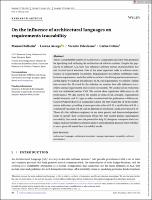Por favor, use este identificador para citar o enlazar este ítem:
https://repositorio.usj.es/handle/123456789/895
Registro completo de metadatos
| Campo DC | Valor | Lengua/Idioma |
|---|---|---|
| dc.contributor.author | Ballarín, Manuel | - |
| dc.contributor.author | Arcega Rodríguez, Lorena | - |
| dc.contributor.author | Pelechano, Vicente | - |
| dc.contributor.author | Cetina, Carlos | - |
| dc.date.accessioned | 2023-02-13T09:23:39Z | - |
| dc.date.available | 2023-02-13T09:23:39Z | - |
| dc.date.issued | 2022-11-27 | - |
| dc.identifier.citation | Ballarín, M., Arcega, L., Pelechano, V., Cetina, C., 2023. On the influence of architectural languages on requirements traceability. Software: Practice and Experience 53, 704–728.. doi:10.1002/spe.3166 | en_US |
| dc.identifier.issn | 1097-024X | en_US |
| dc.identifier.uri | https://repositorio.usj.es/handle/123456789/895 | - |
| dc.description.abstract | Today, a considerable number of Architectural Languages (ALs) have been proposed for specifying and analyzing the architecture of software systems. Despite the popularity of different ALs, how ALs influence software system maintainability has not received much attention. One of the most important tasks in software maintenance is requirements traceability. Requirements traceability establishes links between requirements and other software artifacts, facilitating system maintenance. In this paper, we analyze the influence of ALs on requirements traceability. Taking into account the ALs used by the industry, we analyze how ALs influence traceability among requirements and architecture models. We conducted an evaluation with our industrial partner CAF. The results show significant differences in AL performance. We also analyze the results in terms of AL concepts, requirements model elements, and AL type in order to understand the performance differences. General-Purpose/Research Languages achieve the best results for all of the performance indicators, providing a mean precision value of 0.51, a recall value of 0.38, a combined F-measure of 0.40, and an Matthews Correlation Coefficient value of 0.33. Those ALs that influence engineers to use more generic and domain-independent terms to specify their architectures obtain the best results during requirements traceability. Our results have the potential to help AL designers to improve their languages and also to help practitioners make a more informed decision about whether or not a given AL meets their traceability needs. | en_US |
| dc.format.extent | 25 p. | en_US |
| dc.format.mimetype | application/pdf | en_US |
| dc.language.iso | eng | en_US |
| dc.publisher | Wiley | en_US |
| dc.relation | Secretaría de Estado de Investigación,Desarrollo e Innovación, Grant/AwardNumber: RTI2018-096411-B-I00 | en_US |
| dc.relation.requires | Adobe pdf | en_US |
| dc.rights | Attribution-NonCommercial-NoDerivatives 4.0 Internacional | * |
| dc.rights.uri | http://creativecommons.org/licenses/by-nc-nd/4.0/ | * |
| dc.subject | Architectural languages | en_US |
| dc.subject | Architecture description language | en_US |
| dc.subject | Requirement traceability | en_US |
| dc.subject | Software | en_US |
| dc.subject | Maintenance | en_US |
| dc.title | On the influence of architectural languages on requirements traceability | en_US |
| dc.type | journal article | es_ES |
| dc.relation.publisherversion | https://onlinelibrary.wiley.com/doi/full/10.1002/spe.3166 | en_US |
| dc.identifier.publicationfirstpage | 704 | en_US |
| dc.identifier.publicationlastpage | 728 | en_US |
| dc.identifier.doi | 10.1002/spe.3166 | en_US |
| dc.rights.accessRights | open access | es_ES |
| Aparece en las colecciones: | Artículos de revistas | |
Ficheros en este ítem:
| Fichero | Descripción | Tamaño | Formato | |
|---|---|---|---|---|
| On the influence of architectural languages onrequirements traceability.pdf | 2,76 MB | Adobe PDF |  Visualizar/Abrir |
Este ítem está sujeto a una licencia Creative Commons Licencia Creative Commons

